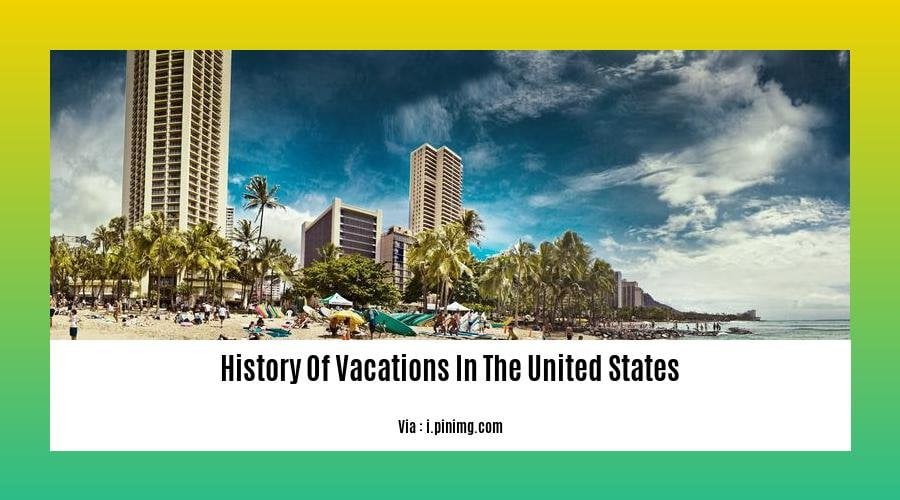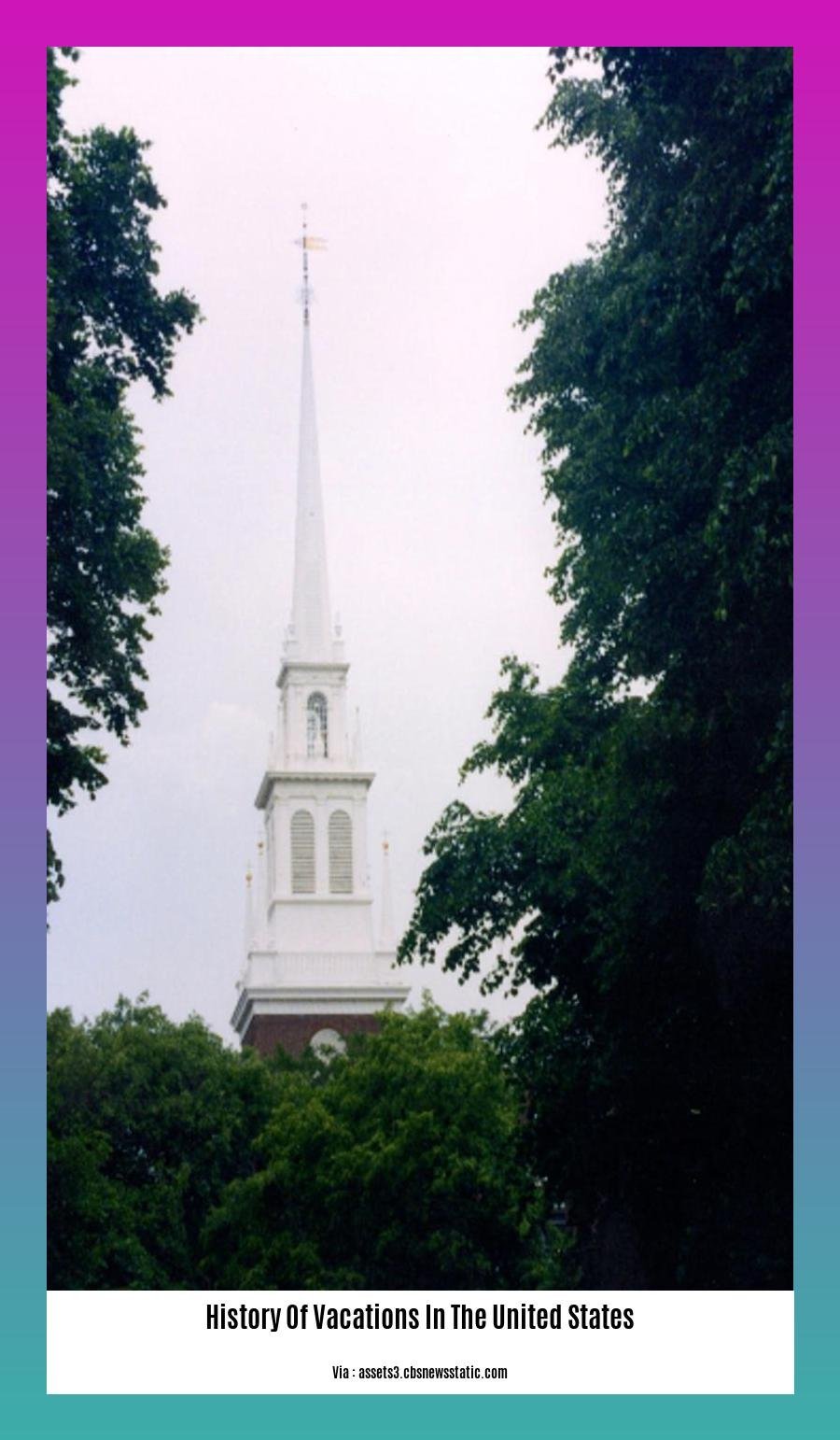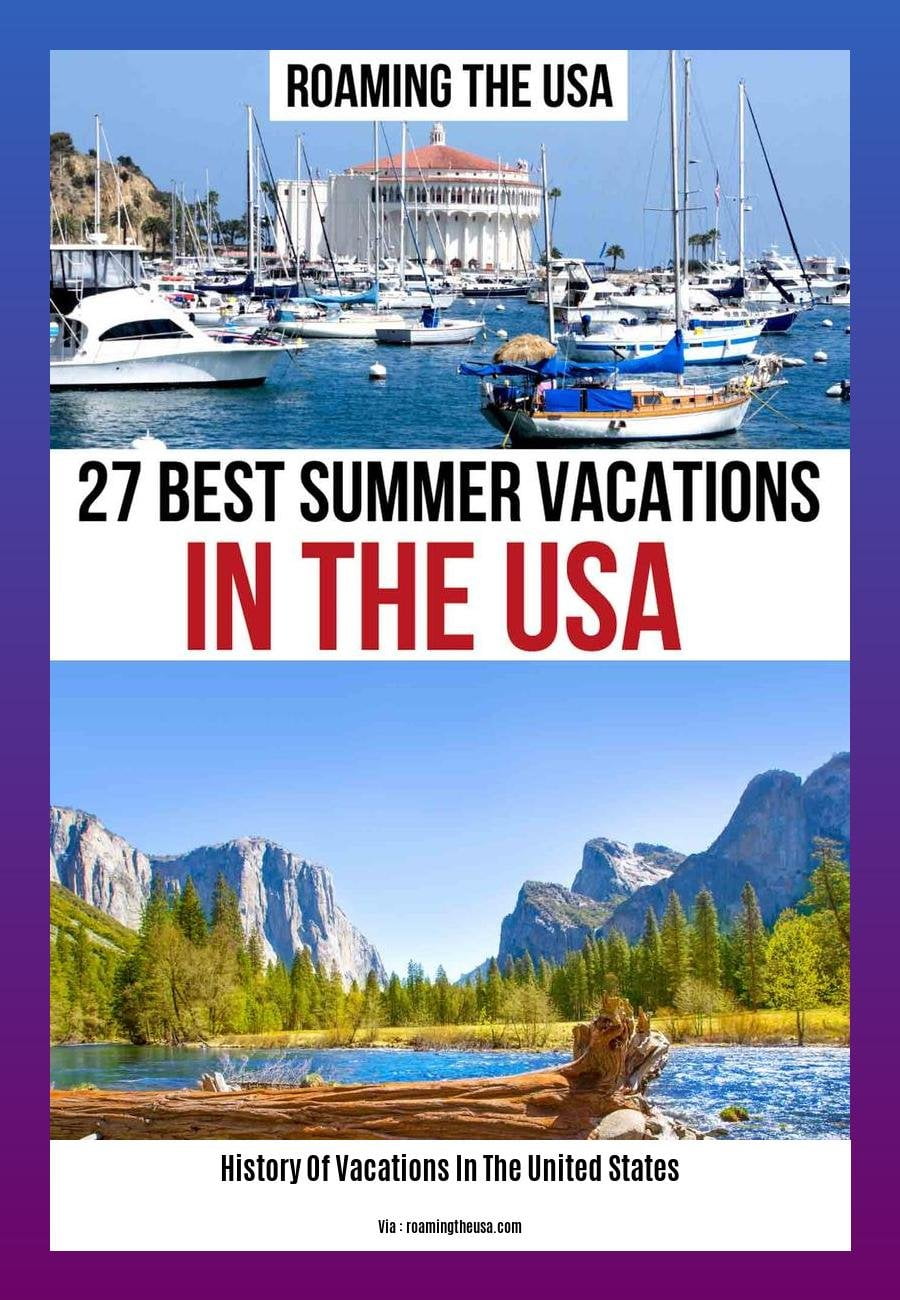Explore the captivating history of vacations in the United States, a journey that traces the evolution of leisure, travel, and the pursuit of relaxation. From the colonial era’s elite escapes to the mass tourism of the 20th century, discover how vacations have shaped American culture and the nation’s pursuit of happiness.
Key Takeaways:
- The railroad made vacations more accessible in the 19th century.
- Wealthy New Yorkers introduced the term “vacation” to describe their summer retreats.
- Paid vacations became more common for workers in the 20th century.
- The automobile allowed families to explore diverse destinations.
- Resorts and hotels grew in popularity to meet the demand for vacation destinations.
- Social media has shaped tourism by promoting unique experiences.
- Technology has made booking and planning vacations easier.
- The COVID-19 pandemic has shifted tourism towards domestic destinations and outdoor activities.
History Of Vacations In The United States

The Evolution of Summer Retreats
In the 19th century, the History Of Vacations In The United States began evolving with the introduction of railroads. Travel expanded beyond the elite, making retreats accessible to more people. Wealthy New Yorkers flocked to summer destinations, coining the term “vacation.”
Blue-Collar Vacations Take Off
The 20th century brought paid vacations for blue-collar workers. The automobile revolutionized travel, allowing families to explore destinations beyond rail lines. Resorts and hotels boomed to meet the growing demand for vacation experiences.
Recent Impacts: Social Media and Technology
Social media has emerged as a powerful force in tourism, highlighting hidden gems and inspiring unique adventures. Advancements in technology have simplified vacation planning and booking. However, the COVID-19 pandemic has impacted the industry, shifting focus to domestic destinations and outdoor activities.
Key Trends in Vacation Evolution
| Era | Key Trends |
|---|---|
| 19th Century | Railroads expand travel, leading to summer retreats |
| 20th Century | Paid vacations become common, automobiles open up new destinations |
| Recent Times | Social media and technology enhance planning, COVID-19 shifts focus to domestic and outdoor activities |
Discover the fascinating history of how we came to enjoy our cherished time off with a deep dive into the profundity of vacation’s origins.
step into the world of religious education with a glimpse into the historical evolution of Vacation Bible School.
explore the intriguing backstory of how vacation rentals came to be the beloved escapes they are today.
Take a trip down memory lane with this in-depth look at the rich tapestry of summer vacation through the ages.
Delve into the origins of the iconic Summer vacation from school and how it came to define our childhood summers.
Uncover the captivating history of Disney Vacation Club and its role in shaping the modern vacation landscape.
Trace the roots of paid vacation and learn how workers fought for and won this essential benefit.
Journey through the evolution of Bluegreen Vacations and its impact on the vacation rental industry.
Go on a sandy stroll through the evolution of beach vacay and its timeless appeal.
Explore the cultural significance of summer vacation in America and its impact on our national identity.
Unravel the linguistic journey of the concept of vacation through the etymology of the word itself.
Role of Advertising and Mass Media in Shaping Vacation Preferences

Vacations have become ingrained in our culture thanks to advertising and mass media, which have played a crucial role in showcasing destinations, fueling wanderlust, and influencing our vacation choices.
Advertising’s Allure:
Advertising campaigns create alluring images of idyllic beaches, majestic mountains, and vibrant cities. These images evoke aspirations and create a longing to experience these destinations firsthand. Through vivid imagery, compelling narratives, and targeted marketing, advertising plays a powerful role in shaping our vacation desires.
Mass Media’s Influence:
Mass media, including television, magazines, and social media, provides a constant stream of travel inspiration and information. Travelogues, documentaries, and online reviews provide a window into different destinations, showcasing their attractions, cultures, and unique experiences. This constant exposure to vacation-themed content fosters a curiosity and desire to explore new places.
Social Media’s Role:
Social media has become a major force in shaping vacation preferences. Platforms like Instagram and Pinterest offer a glimpse into the travel experiences of friends and influencers, inspiring wanderlust and providing ideas for new destinations. User-generated content and reviews play a significant role in building trust and credibility, influencing our decisions and ultimately shaping our vacation choices.
Key Takeaways:
- Advertising creates alluring images of destinations, fueling vacation desires.
- Mass media provides a constant stream of travel inspiration and information.
- Social media showcases the travel experiences of others, inspiring wanderlust and influencing vacation choices.
Citation:
- The History of Vacations in the United States
- The Roles of Social Media in Tourists’ Choices of Travel Components
Influence of Social and Economic Factors on Vacation Patterns
In the tapestry of American history, vacations are an ever-evolving thread, intimately intertwined with our nation’s social and economic transformation. From humble origins as isolated health escapes to today’s widespread pursuit of adventure and relaxation, vacations have served as a barometer of our collective prosperity and cultural priorities.
Transportation Revolution
The advent of railroads in the 19th century was a pivotal moment. Suddenly, travel became accessible to the masses, introducing the concept of summer retreats for city dwellers. This, coupled with the rise of a middle class, created a burgeoning demand for vacations.
Economic Prosperity
As the United States industrialized, its citizens became increasingly affluent, enabling them to explore vacation destinations beyond their immediate surroundings. Paid vacations became common for blue-collar workers in the 20th century, further expanding the pool of potential vacationers.
Social Norms
Conventions played a significant role in promoting vacations. By attracting vacationers and providing a social outlet for middle-class families, conventions helped establish vacations as a cultural norm.
Supply and Demand
The interplay of supply and demand shaped the evolution of vacations. As infrastructure developed and vacation destinations proliferated, the availability of vacation options increased, leading to greater participation.
Current Trends
Social media has emerged as a powerful force in vacation planning, showcasing hidden gems and inspiring adventurous journeys. Technology has simplified the booking process and made vacations more accessible than ever.
Key Takeaways:
- The growth of transportation networks facilitated mass travel and fueled the rise of vacations.
- Economic prosperity empowered Americans to explore vacation destinations beyond their immediate surroundings.
- Conventions and social norms played a significant role in promoting vacations as a cultural norm.
- Supply and demand have shaped the evolution of vacation destinations and participation.
- Social media and technology have transformed vacation planning and made vacations more accessible.
Citations:
- Working at Play: A History of Vacations in the United States
- Vacations and the Quality of Life: Patterns and Structures
Historical perspectives on the meaning and purpose of vacations
Vacations have come a long way since their humble beginnings as summer retreats for the wealthy in the 1700s. Today, they are a staple of American life, something that most of us take for granted. But what is the historical significance of vacations? What has changed about them over time? And what do they tell us about our culture?
One of the most important things to remember about vacations is that they are a relatively new phenomenon. For most of human history, people worked long hours and had little time for leisure. It wasn’t until the Industrial Revolution that people began to have more free time, and it wasn’t until the late 19th century that vacations became common for the middle class.
The rise of vacations was closely tied to the development of transportation networks. In the early 19th century, steamboats and railroads made it possible for people to travel long distances relatively quickly and cheaply. This led to the growth of seaside resorts and other vacation destinations.
The meaning and purpose of vacations have also changed over time. In the early days, vacations were seen as a way to relax and escape from the heat and noise of the city. Today, vacations are often seen as a way to explore new places, learn about different cultures, and bond with family and friends.
Key Takeaways:
- Vacations are a relatively new phenomenon, becoming common for the middle class in the late 19th century.
- The rise of vacations was closely tied to the development of transportation networks.
- The meaning and purpose of vacations have changed over time, from being seen as a way to relax to being seen as a way to explore and experience new things.
Relevant URL Sources:
- The History of Vacations in the United States
- Where Was the Birthplace of the American Vacation?
FAQ
Q1: How did the railroad impact the history of vacations in the United States?
Q2: What role did labor unions and government policies play in the development of paid vacations in the US?
Q3: How has social media influenced the tourism industry in recent years?
Q4: How did “conventions” contribute to the rise of the vacation industry in the early 19th century?
Q5: What were the origins of the term “vacation” in the United States?
- Revolution Space: Disruptive Ion Propulsion Transforming Satellites - April 24, 2025
- Race Through Space: Fun Family Game for Kids - April 24, 2025
- Unlocking the Universe: reading about stars 6th grade Guide - April 24, 2025
















